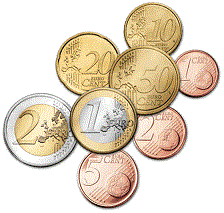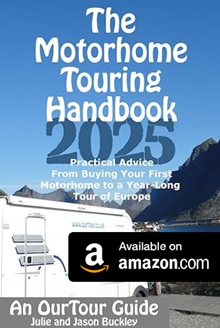Hi! This post’s all about making money from a travel blog. It uses the site you’re looking at (ourtour.co.uk) as an example, giving an account of the actual costs and income we get after operating the blog for the past 20 or so months. Please have a read and if you’ve any thoughts or comments, add them to the bottom of the post, we’ll read them all and are always on the look out for new perspectives and new ideas! Thanks, Julie and Jason

Travel Blog Costs
There are plenty of travel blogging services which you can set up for free, zero cost to you, not a bean. Just search Google for ‘free blog’ and you’ll find dozens of them. Many of these will not allow you to earn money through the methods outlined below though, and may place other restrictions on you, such as enforcing a particular format of URL, or only allowing limited flexibility in layout. Do your research before choosing a blogging platform; at the time of writing Google Blogger allows both Google Adsense and Amazon Associates links.
This blog (ourtour.co.uk) is not hosted on a free platform. It runs on a shared server we rent from a company called Hostgator and costs around £100 for three year’s hosting costs. The URL (ourtour.co.uk) costs roughly £10 for three years. You can hunt around for better deals of course! We also have Google Drive storage for making a site back-up, which costs £20 per year for 25GB. The blog uses the WordPress content management system, which is free of charge, as are all the little plug-ins we use to display maps and so on. We also choose to buy 3G Internet access while we travel, which usually costs us around £25 per month for between 3GB and 5GB of data. All in all, the blog takes maybe £350 per year, but we also get Internet access for emails and the like included in this cost.
The other cost is, of course, your time. We spend between an hour and two hours a day updating the site. This doesn’t include the time used to take photos and video, which we’d be doing even if we didn’t run a blog as we love it.
Travel Blog Income
On the flip side, it is possible to make money from running a blog, but unless you’re fanatical about it (we’re more serious than most), then the reality is your tour won’t be extended much from the income, sorry! Our main reason for running this blog isn’t the income but the sheer satisfaction of getting comments back to say thanks. That said, we have made some cash from our little blog, much of which is dependant on the amount of traffic the site attracts. To give you an idea of how many people visit our site (which generate for us the amounts we’re talking about below) we’ve used a report which Hostgator provide us with (called Awstats), ourtour.co.uk is now 20 months old and as of May 2013 gets around 1000 visits per day, serves up on average 3500 pages per day and about 9000 unique visitors per month read it.
– Google AdSense
Google AdSense works like this: you register with the service for free which gives you access to a web interface. You can then create adverts of various formats (banners, square, text-based) and choose which categories of advertiser you want to be displayed. You then place the advert onto your page and Google analyses your content to decide which ads are best suited to the audience. When someone clicks on an ad, you get a few pence for it, the actual amount depends on the advert (which you have no control over). You cannot encourage people to click on the ads, Google are hot on this and will blacklist you if they find your site pulling more clicks than it should. You get paid per click, regardless of whether people actually buy anything from the target site. You also get paid a very, very small amount for the number of times the adverts are shown, so even if there are no clicks, if you have enough pages viewed on your site you’ll still generate a few pence.
We have a few Google Adsense adverts on the site which make us around £10 per month.
– Amazon Associates
Amazon will pay you for attracting customers to their site, giving you a small percentage of the profit they make from purchases that customer makes in that session. The cost to the purchasers remains the same. You register for the service at Amazon, which is again free and gives you access to a web interface from which you can build graphic or image-based links to Amazon products, or small widgets like the ‘search’ box to the right of this page. Amazon Associates differs from Adsense as (a) you have more control over the adverts – if you wish you can choose to only link to a specific product or set of products and (b) you only get paid if people place an order in the same session after clicking through to Amazon from your site – you get nothing for the referral itself. Also, you earn more if a customer orders the actual item you linked to (a direct referral) rather than another item (an indirect referral).
We occasionally place in-line links to Amazon products we mention within our pages, have banners on some pages, and have an Amazon search widget in the sidebar on the right. Between Jan and Mar 2013, these links resulted in sales of 50 items worth £844 to Amazon, of which we received a commission of £21.
– Affiliate Marketing
There are a whole range of other affiliate marketing schemes you can join. Some are operated by a middle man, who checks your site for content and relevance, and asks you to prove ownership, and then gives you access to a web interface to build up adverts. Others are operated directly by the company themselves. We tried both methods, linking to Hostgator, Vodafone and Caxton FX, and over a period of months and we earned nothing, not a penny (but then we never overtly pushed these products).
– Own Brand Marketing
We’ve written two books while we’ve been on the road, and we link to these from the site:
As they’re for sale through Amazon, this means that if a person clicks through to buy them from our site we also get paid a small commission through Amazon Associates (see above), as well as the profit from the sale of the book itself. The amount we make from Amazon Associates is included in the figure above.
– Third Party-Specific Advertising
As the site’s slowly built up traffic, we’ve received a fair few offers via email from third-party companies asking to place adverts on the site, or for us to write content promoting a specific company or product. The amount of money to be made from these depends on the deal being offered and your own negotiating skills, but might be typically £50 per year to host an advert. We’ve steered clear of these, not that we think there’s anything inherently wrong with this, we just don’t want to find ourselves having to change the way we write, or promoting a product we know nothing about.
In Summary
So, adding up what the site costs us (excluding our time) and what we make back in adverts and commission, the blog actually costs us about £200 a year to run. If we’d chosen a free hosting platform, and only updated the blog when we could obtain free WiFi, then we might be making around £180 per year. This here blogging’s not a path to riches, not for us at least, but we love it anyway.
Post Script
There are other ways to make cash on the road via your blog. Some folks, far more adventurous than us, tried a KickStarter project to fund their travel across China, have a look here on their blog to see how they did. Another option’s to add a ‘buy us a beer’ (donate to us) button. Another’s to use the blog as a way to attract more lucrative freelance writing jobs, and by choosing to write about each destination through a number of lenses (the food, people’s pets, wildlife, the weather, the roads, fishing, snorkeling, architecture, politics – you name it, you can write lots of varied articles about the same place). For someone who’s managed to make a living from travel blogging, have a look here.



